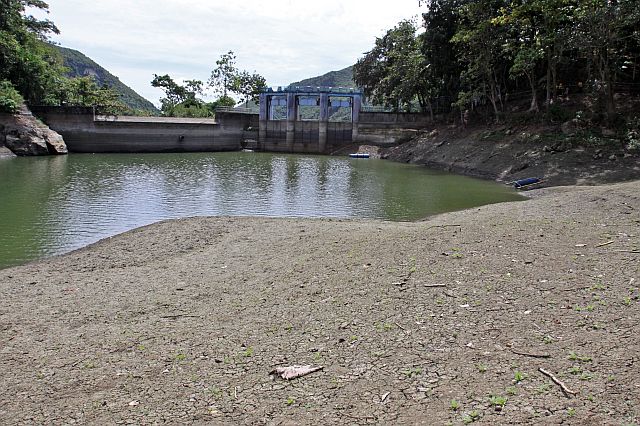
Buhisan Dam (CDN PHOTO/JUNJIE MENDOZA)
Conserve water.
This was the advisory from the Metropolitan Cebu Water District (MCWD) yesterday after it announced that the surface water supplies in Cebu City and province have started to drop to a dangerous low.
Faced with below-normal rainfall in Cebu since the start of the year, and with no rain in sight due to the onset of the summer months, the water supply in Buhisan Dam, located in Barangay Buhisan in Cebu City, has reached critical level, according to MCWD production division head Rebecca Husayan.
Buhisan Dam is now producing only 1,400 cubic meters of water instead of its usual production of 5,000 cubic meters to 7,000 cubic meters daily, she revealed.
Husayan said they were now using part of the reserve from the Jaclupan Dam in Talisay City to compensate for the shortfall of supply from Buhisan Dam, a key source of water for Metro Cebu.
“With the peak of summer (approaching) and with less rainfall, there’s no (water to) recharge (the rivers). This means (that) Mananga River and the Buhisan Dam (are drying up). There’s only a trickle of water in Mananga River (in Talisay City),” Husayan told Cebu Daily News yesterday.
She said the water supply in Buhisan Dam started dropping from 4,000 cubic meters to 2,000 cubic meters in January this year and eventually down to 1,400 cubic meters by late February.
This was the reason why for the past two weeks, Husayan said MCWD has been using part of the production of Jaclupan Dam to stabilize water supply in Metro Cebu, which is primarily intended as a reservoir in the event there is water shortage.
Currently, Jaclupan Dam still produces an average of 28,000 cubic meters per day, but it is already lower than its usual daily production of 30,000 cubic meters to 35,000 cubic meters.
However, Husayan stressed that even if Jaclupan Dam’s production has decreased, “the situation is still manageable.”
LOW WATER PRESSURE
For consumers, the shortfall in water supply means problems on water pressure, especially in elevated areas during peak hours, she added.
Peak hours are from 4 a.m. until 10 p.m., she added.
Husayan assured MCWD has no immediate plan to resort to water rationing within its service areas since the water district could still supply water to all its clients, except that there will be low water pressure in some areas in the cities of Cebu and Talisay.
According to MCWD’s distribution division, the areas easily affected by low water pressure will include Nivel Hills in Barangay Lahug, Ponce Compound in Barangay Carreta, Banawa in Barangay Guadalupe, Urgello Street in Barangay Sambag II, and the whole of Barangays Tisa,
Mambaling and Pardo, all in Cebu City; and Barangay Lagtang and part of Barangay Pooc, both in Talisay City.
Husayan, however, said that while only a few areas will be affected by low water pressure, MCWD is still asking all its water concessionaires to practice storing water every day so that they will have something to use in case of a shortage or if there will be emergency repairs that have to be done on the water district’s distribution pipes.
“We believe the supply in Jaclupan can still last until the peak of summer in April and May. It might not be as much as 28,000 cubic meters anymore but it will not go down to 20,000 cubic meters unlike in July last year, which was the lowest,” Husayan said.
With the Philippine Atmospheric, Geophysical and Astronomical Services Administration (Pagasa) forecasting the gradual weakening of the El Niño weather phenomenon this year, supply will continue to be manageable, she added.
NEAR NORMAL
Based on the state weather bureau’s latest advisory posted on its website on Feb. 9, the dry spell brought on by the El Niño weather disturbance will weaken through March, April and May this year.
In January, most parts of the country experienced way below to below-normal rainfall, according to Pagasa.
The weather bureau said Cebu and 13 other provinces are expected to have “near-normal” rainfall as these areas are no longer affected by any dry condition, dry spell or drought resulting from the El Niño weather phenomenon.
“Pagasa will continue to closely monitor the on-going strong El Niño condition and updates shall be issued as appropriate. Meanwhile, concerned agencies are advised to take precautionary actions and intervention measures to mitigate adverse impacts of El Nino,” said Pagasa
Acting Administrator Vicente Malano in the advisory.
For their part, Husayan said they looked forward to the continued dissipation of the El Niño so that, hopefully, the rainy season will start by
June or July this year, unlike what happened last year when rainy season came to Cebu already late in the year.
Disclaimer: The comments uploaded on this site do not necessarily represent or reflect the views of management and owner of Cebudailynews. We reserve the right to exclude comments that we deem to be inconsistent with our editorial standards.
